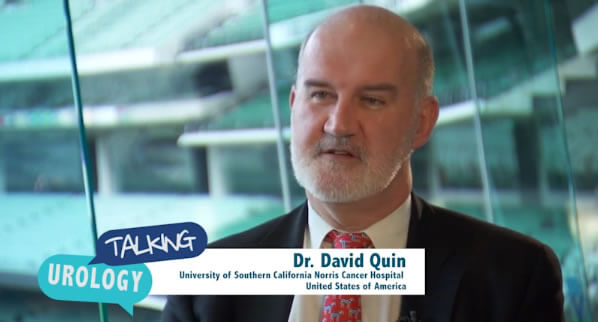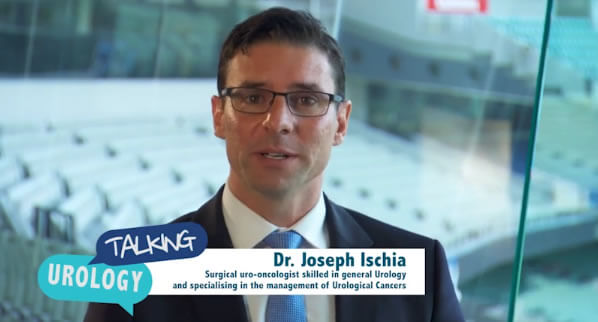USANZ 2017 – Dr Chris Chapple
Professor Christopher Chapple is a Consultant Urological Surgeon at Sheffield Teaching Hospitals and Visiting Professor at Sheffield Hallam University.
Professor Chris Chapple discusses the underactive bladder.
Talking Urology podcast transcript
USANZ 2017 Interviews – Chris Chapple
This is Talking Urology
Joseph Ischia: It was a pleasure to catch up with Chris Chapple, who is the Professor of Urology at Sheffield Hospital. He’s really one of the doyens of functional urology in his international reputation. I really appreciate you joining us. You have an excellent talk on detrusor underactivity, and if you could give us the highlights of that talk?
Dr Chris Chapple: Thank you. It’s a great pleasure and honor to be here at the USANZ conference again. Certainly, detrusor underactivity is a very important condition which increases with age affecting around 30% to 50% of people over the age of 65 to 70, and it’s one of those other conditions, unless you actually consider its presence, you won’t necessarily recognize it. And it’s clearly important because if the bladder is not working properly then it can lead on to both storage and voiding symptoms and be misconstrued as being either overactive bladder or in fact bladder outlet obstruction. So, it’s very important to bear in mind that this could be present because if you got an underactive bladder with storage symptoms although it’s predominantly avoiding dysfunction, with this large residuals, that could lead onto storage symptoms and if you treat it like overactive bladder you could actually make matters worse. Conversely, if it’s concurrent with the symptoms of voiding dysfunction, which is the norm, then you may treat it as bladder outlet obstruction, and in the male patient, if you don’t recognize it, you may get less than excellent outcome from transurethral resection surgery for instance. So, it is important to consider it.
Joseph Ischia: And how common is it?
Dr Chris Chapple: Well, the evidence is limited because the only way you can definitively make the diagnosis is with a pressure flow study. You can infer its presence by looking at bladder diaries and flow rates and residuals, in particular residuals where you’ve got a large post voiding residual, that’s if you like a proxy for it. The evidence so, from the limited number of urodynamic studies and then from epidemiological data using frequency volume charts, flow rates and residuals, would suggest that it increases in the incidence with age and affects approximately 30% to 40% of people over the age of 70, and that’s often, in those people, also associated with some degree of overactivity during the filling phase. In fact, many years ago, Resnick, from Pittsburgh, described DHIC syndrome which is detrusor hyperactivity with impaired contractility. And this all goes down to the fact that our conventional concept about the detrusor not so being the most important target for therapy is, in fact, rather a simplification. In fact, we now understand in 2017 that the major target for many therapies is the sensory mechanisms which involves not only the peripheral innovation, sensory innovation at the level of the urothelium and suburothelial plexus but also, of course, the spinal cord and the central mechanisms. And, in fact, all of our existing therapies work predominately on those levels although most people think that they’re working on the detrusor muscle. But clearly, you can have a completely clapped out detrusor and obviously that will be important if it’s underactivity, but in many cases it’s in fact a more subtle problem which is related to aging affecting innovation.
Joseph Ischia: Okay, so it’s common, it can be hard to diagnose. Can we do anything about it if we do diagnose it?
Dr Chris Chapple: Well, I think the first thing is to be aware of it as a possibility coz obviously you won’t diagnose this unless you think about it. And so if somebody has got a large residual always bear in mind it may not just be outlet obstruction but in fact may be impaired contractility and that could be related to the detrusor muscle or more commonly due to the sensory innovations and neuroanatomical factors. So what can you do about it? Well, clearly if a patient has got an increased residual think in terms of the voiding efficiency. The voiding efficiency is where you relate the residual to the functional capacity which is a voided volume plus the residual, which first of all you cannot diagnose unless you use a bladder diary and that’s in all the guidelines although many people don’t tend to use these or think about them. Having done that, if you’ve got a voiding efficiency of 40% which is a threshold, in other words that’s a residual of 200 with a functional capacity of 500 for instance, then you can see if the patient is symptomatic or not. If they’re not symptomatic, then it’s reasonable just to observe the situation probably with yearly ultrasound, check the upper tracts, and so on. If, however, they’ve got a larger residual and symptomatic, then intermittent self-catheterization is the easiest thing to do. You can, of course, in the female do urethral dilation, recalibration which has got limited efficacy and obviously you want to try and avoid intervention less necessary. In fact, the gut reaction people have with residuals is to start catheterization. Often it’s not necessary, it’s just a matter of careful observation on the patient.
Joseph Ischia: Does sacral neuromodulation work?
Dr Chris Chapple: Well, sacral neuromodulation really will only work if there’s already a detrusor function, and the evidence from the Netherlands from recent work, where they looked at this very closely, is it didn’t work for patients who had a nonfunctioning detrusor. If there is detrusor contractility, you do get some effect but the efficacy depends on how good the contractility is.
Joseph Ischia: Have you wrapped any bladders with rectus muscles?
Dr Chris Chapple: Well, the work which came from Arnes Stensil, when he was working in Austria and he has carried on with the multicenter study which he reported recently from India and also from Germany, showed that in very carefully selected cases you can get a success rate around 60% to 70%. But here, you’re talking about patients where there is a limited neurological lesion and you’re talking about an operation which takes six to eight hours with three surgical teams in where you’re moving latissimus dorsi muscle wrapping the bladder and revascularizing the muscle with microsurgery. So, it’s not something just to be able to take in lightly. So, it’s one end of the spectrum.
Joseph Ischia: Thank you very much. It’s been an absolute pleasure to have you, Chris. I really appreciate it.
Dr Chris Chapple: Thanks, Joe.
Joseph Ischia: We appreciate you coming to Melbourne. Now, have you enjoyed your trip to Australia?
Dr Chris Chapple: Yes, I always do. It’s great. I’ve got so many friends here in Australia and it’s always great to meet some new friends, and I must say that we’re very proud of the strong link we have with USANZ at the European Association Urology and we’ve certainly increased our strong collaboration together in recent years not only in terms of many members of USANZ becoming joint members of the EAU, but the adoption of the EAU Guidelines by USANZ and our collaborative work together on that along with our collaborative work on patient information, our exchange program which we have for the residents both with European residents coming to your residence meeting and residents from USANZ coming across to the Europe, of course. So, we look forward to that increasing and going from strength to strength.
Joseph Ischia: Fantastic and that’s a great point you make out. USANZ membership does now get us an EAU membership with all the associated benefits, so it’s a fantastic camaraderie for us.
Dr Chris Chapple: And I hope people will come to the EAU meeting maybe in London next month. But if not, for future meetings where you got the first glimpse of what’s happening in academic urology every year and where we’re expecting attendance of around 14,000 people in London next month.
Joseph Ischia: And a technical point for the Australian urologist, you need to make sure you’ve ticked the box saying you’re happy to have your details shared with the EAU. So, it’s not automatic if you haven’t ticked that box so just check that out. All right, thank you very much.
Dr Chris Chapple: It’s a pleasure.










